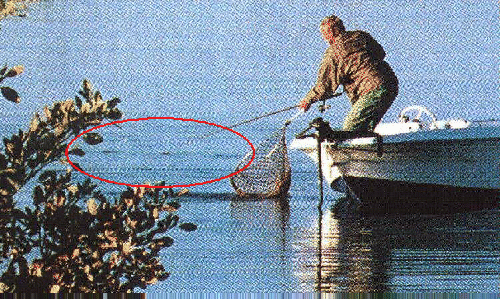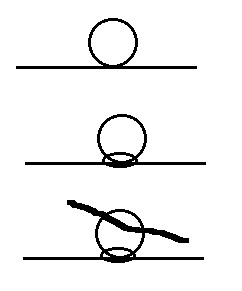KARIBA ANGLING SOCIETY
Junior/Beginners BookletOnline
Chapter
Six - Bottlenose
(Latin name - Mormyrus longirostris - Eastern Bottlenose)
 These
are not generally easy fish to find, or to catch.
These
are not generally easy fish to find, or to catch.
They tend to hang around in shoals from a few fish to lots of fish,
sometimes big fish, sometimes small. Generally the fish in a shoal will
all be around the same sort of size.
The first thing to look for are the bubbles. That sounds easy I
hear you say. NO it is not that easy. The
bubbles are created by the fish sucking in water, and blowing it back out
into the bottom to stir it up, and the food is blown around too, and they
then eat the swirling worms and other insects etc.
An important point to remember here is that
when they bite they are literally "Standing on their heads", and the direction
of your strike is relatively important.
 You will
often see little sets of bubbles coming up from the bottom, but these are
not what you are looking for. The smaller fish do send up just small bubbles,
but the bigger fish send up big bubbles and a lot of small bubbles to go
with it. (See the picture on the left)
You will
often see little sets of bubbles coming up from the bottom, but these are
not what you are looking for. The smaller fish do send up just small bubbles,
but the bigger fish send up big bubbles and a lot of small bubbles to go
with it. (See the picture on the left)
The bigger bubbles rise to the surface together, and then smaller
bubbles tend to follow, and these often appear in bursts, but when there
are a lot of big fish together, it appears as a lot of bubbles and
rotting vegetation coming to the surface and every now and again it stops
for a short while and then starts again.
At times the water will literally continuously "boil" like the inside
of a kettle, and there will be a lot of rubbish coming up with the bubbles.
(See
the picture below, look in the red outline)

(PS The fish in the net was just over the
record, over 9.9 kgs, but given away to someone to eat)
It does help a lot if you have calm water
to be able to see the bubbles, so go looking for them early in the morning,
and look around any areas where there are trees and the water is calm,
especially in rivers. Also watch for floating bits of grass and weed, fairly
short and rotten, and also snail shells, this is a sure sign that they
have been feeding in the area.
Rigging up
The rods used for this species do not need to be "broomsticks",
a typical bream rod with light line (8 to 10 pound test) will suffice and
provide a good fight with these funny looking fish.
Many anglers simply fish with a "ledger" rig straight on the bottom
and "try" to feel the bite, but I have generally found that it is easier
to fish with a running float and ledger rig, as it helps in timing your
strike and is definitely a more positive indicator of the bites (and I
seem to hook more fish per bite this way).
Some anglers have the hook running through the sinker, it is a personal
choice, and both methods appear to be as successful as each other.
Also if you are unsure of how far above the botom to set your hook,
you can have a second hook set on the line above the other until you have
established how high they are feeding around the bottom.
 The
running float is rigged with a stop knot (or bead) such that it sticks
out of the water vertically, and you need quite a large sinker on the bottom
to make the float "set" so you can see the bites, generally 1/2 to 3/4
ounce will provide a sufficient anchor for your float.
The
running float is rigged with a stop knot (or bead) such that it sticks
out of the water vertically, and you need quite a large sinker on the bottom
to make the float "set" so you can see the bites, generally 1/2 to 3/4
ounce will provide a sufficient anchor for your float.
The "stop" knot is very easy to do, (see the
diagram on the left) you simply make a slip knot in the line
approximately where you think the depth is right and put a short piece
of dental floss or soft line through the slip knot and pull it tight. The
Floss/Soft line will then tie itself round the line fairly tightly and
you can move it up and down as required.
At the bottom where you are going to put your hook and sinker, it
is best to use a swivel to tie these on to. The reason is very simple,
so the knot you made for the hook and sinker does not get stuck in the
bottom eye of the float, thus making you wind it all in and sorting it
out, and then recasting. If you do not have three way swivels, a single
swivel works just as well.
Actually Fishing and the bites
Once you (think you) have found a shoal, you can anchor fairly close
to them if they feeding vigorously (don't drop the anchor on their heads),
else anchor a SHORT distance away, so that you can "flip" your float and
bait to where they are. This will help you see the bites. If the water
is calm, and you have an electric trolling motor you can keep yourself
in the area with that, and fish very successfully, in fact this is the
preferred method of staying in the area, rather than anchoring. Try not
to get right on top of them, but keep them on the side of the boat.
If you do anchor, try and get the boat between the fish and
the wind to smooth out the waves behind you. This will help you to keep
an eye on the feeding activity and position of the fish when the wind comes
up.
Use a single worm on a size 8, 6 or 4 hook (size dependant
on the size of the fish, start medium 6), with the worm fed onto the hook
with some dangling off the top and some off the end, so the worm has a
bit of movement and can wriggle a little. This appears to help.
Simply cast or flip to the middle of the bubbles, and let the sinker
get to the bottom and have an inch or two of your float sticking out of
the water, such that you can see the bites as they pull it down a little.
The line between rod and float should be fairly slack, but not too
much line, as you will need to strike successfully, and also too much line
in the water will "drag" with the waves and wind, and your float will slowly
but surely disappear from view under the water as the line drags
away in the water current on the surface.
The bites vary, from what you think are those little robbers
to a good hard tug. The time to strike is when the float goes down under
the water, as they move off with the worm.
The strike should be positive, but not too hard to rip the hook
out of their mouths, which are quite soft if you catch them in the lips.
Most times, if they are moving off with the bait, the hook will be deep
enough in their mouths for a good hook up.
The fishing depth can be anywhere from 5 foot up to 25 or 30 feet.
You may find that sometimes they are very skittish, especially if
there are a lot of crocs around, or there has been a lot of noise, and
they will disappear at any sudden noise or disturbance. Wait a while and
see if they come back. The deeper they are the less skittish they tend
to be.
Generally, once you have found them (and they are feeding)
you will be able to catch quite a few in just a couple of hours, so unless
you intend eating them, please don't decimate them,they
are hard enough to find already.
THEY DO GIVE ELECTRIC SHOCKS
(MORE OF A STRONG TINGLE) WHEN GRABBED WITH YOUR HANDS OR A WET CLOTH.
Back to
Chapter 6 Top of Page | Back to Chap
6 Menu |
Back to Main Page
 You will
often see little sets of bubbles coming up from the bottom, but these are
not what you are looking for. The smaller fish do send up just small bubbles,
but the bigger fish send up big bubbles and a lot of small bubbles to go
with it. (See the picture on the left)
You will
often see little sets of bubbles coming up from the bottom, but these are
not what you are looking for. The smaller fish do send up just small bubbles,
but the bigger fish send up big bubbles and a lot of small bubbles to go
with it. (See the picture on the left)

 These
are not generally easy fish to find, or to catch.
These
are not generally easy fish to find, or to catch.
 The
running float is rigged with a stop knot (or bead) such that it sticks
out of the water vertically, and you need quite a large sinker on the bottom
to make the float "set" so you can see the bites, generally 1/2 to 3/4
ounce will provide a sufficient anchor for your float.
The
running float is rigged with a stop knot (or bead) such that it sticks
out of the water vertically, and you need quite a large sinker on the bottom
to make the float "set" so you can see the bites, generally 1/2 to 3/4
ounce will provide a sufficient anchor for your float.